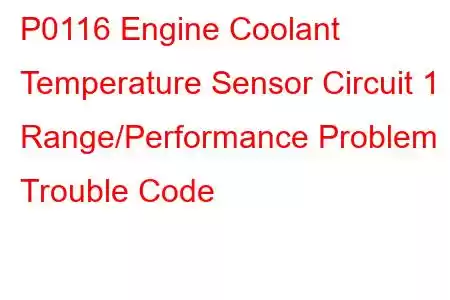P0116 ECT Sensor Circuit Range/Performance
OBD-II Trouble Code Technical Description
Engine Coolant Temperature (ECT) Sensor Circuit Range/Performance
What does that mean?
This diagnostic trouble code (DTC) is a generic powertrain code, which means that it applies to all 1996-newer vehicles (Ford, Hyundai, Kia, Mazda, Mercedes-Benz, etc.). Although generic, the specific repair steps may vary depending on make/model.
The ECT (Engine coolant temperature) sensor is a thermistor which changes resistance based on temperature of the coolant in contact with it. The ECT sensor will be located in the block or coolant passage. Usually it is a two wire sensor. One wire is a 5 Volt supply from the PCM (Powertrain Control Module) to the ECT. The other is a ground to the ECT.
As the temperature of the coolant changes the resistance on the signal wire changes accordingly. The PCM monitors the reading and determines coolant temperature in order to perform essential engine fuel management. When engine coolant is low, sensor resistance is high. The PCM will see a high signal voltage (low temperature). When coolant is warm, the sensor's resistance is low and the PCM will see a high temperature. The PCM expects to see slow resistance changes on the ECT signal circuit. If it sees a quick change in voltage that isn't consistent with an engine warming up, this P0116 code will set. Or if it sees a lack of change in ECT signal, this code may set.
Symptoms
There may be no noticeable symptoms if the problem is very intermittent, however the following may occur:
MIL (Malfunction Indicator Lamp) illumination Poor drivability Black smoke at tailpipe Poor fuel economy May not idle May exhibit stalling or misfiresCauses
Potential causes of the P0116 code include:
Missing or stuck-open thermostat Bad ECT sensor Short or open on signal wire Short or open on ground wire Poor connections in wiring
An example of an Engine Coolant Temperature ECT sensor
Possible Solutions
If there are any other ECT sensor codes, diagnose them first.
Using a scan tool, check the ECT reading. On a cold engine, it should match the IAT reading or should be equal to ambient (outside) temperature reading. If it does match the IAT or ambient temp, check the freeze frame data on your scan tool (if equipped). The saved data should tell you what the ECT reading was when the fault occurred.
a) If the saved info indicates that the engine coolant reading was at the coldest exreme (around -30 deg. F) then that's a good indication the ECT resistance was intermittently high (unless you live in Anchorage!) Check for an open in the ECT sensor ground and signal circuits and repair as necessary. If they appear okay, warm the engine up while monitoring the ECT for any intermittent jumps high or low. If there are replace the ECT.
b) If the saved info indicates that the engine coolant reading was at the warmest exreme (around 250+ deg.F) then that's a good indication the ECT resistance was intermittently low. Check for a short to ground on the signal circuit and repair as necessary. If it appears okay, warm the engine up while monitoring the ECT for any intermittent jumps high or low. If there are replace the ECT.
Other ECT sensor and circuit related DTCs: P0115, P0117, P0118, P0119, P0125, P0128
Read: 54


